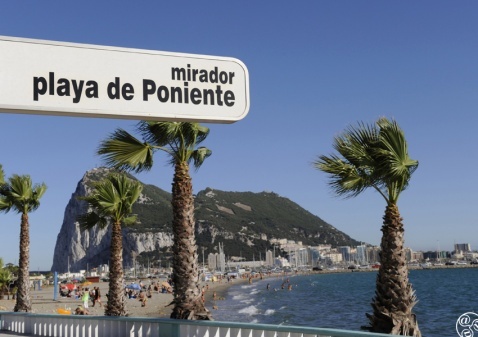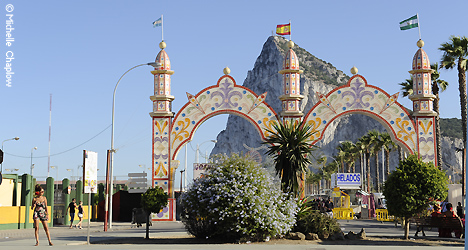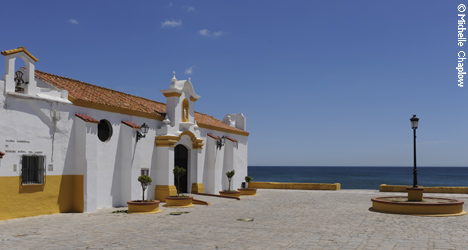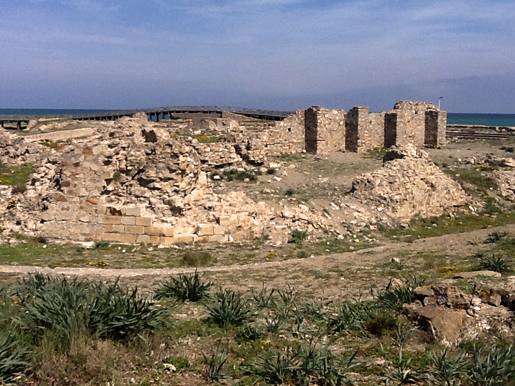
'The Gateway to Gibraltar' - La Linea |
|
The coastal town of La Línea de la Concepción - more commonly known simply as 'La Línea' (meaning 'boundary line' in Spanish), is often referred to as 'The Gateway to Gibraltar' and as you approach it for the first time, you will soon know why. It forms the boundary between the famous and British territory of Gibraltar and Spain.
Many of the over 60,000 residents of La Línea work in Gibraltar, commuting between the two each day. Some Gibraltarians have jobs in Spain and other come to La Linea for shopping or a night out. Not forgetting the Wednesday market, the summer Ferria or the large beaches. There is a great deal of interaction between the two town as well as close socio-economic links. La Linea does have a border town feel to it.
Gibraltar relies on La Línea for the supply of fresh fruit, vegetables, meat and fish as well as many other products. There is also a Spanish military presence in La Línea and some interesting fortifications to see. La Línea has a pretty marina and port area and two beaches one along each peninsular seafront. The beaches are called Playa de Santa Barbara and Playa de Levante. See our La Linea beaches page.

Getting There
Although La Línea is in the province of Cadiz, it is just 70 kilometres (40 minutes drive) west of Costa del Sol's Marbella, in Malaga province. The town nestles on the eastern side of the Bay of Gibraltar. When driving to La Línea from Costa del Sol, you can either take the E15-AP7 toll road at Estepona or take the much slower and many roundabouts of the other road. Both converge at Sotogrande.
When visiting Gibraltar or 'The Rock' (in Spanish, El Peñón), you can park on the La Línea side and walk the one kilometre across the Gibraltar border. If you prefer to drive across and park on the other side, be prepared to wait in a long queue. If you prefer not to drive, there are good bus links from most towns along the coast, including a regular service from Estepona bus station to La Línea.
If going by car to visit Gibraltar, take the CA-34 off the A-7 coast road at San Roque, rather than the earlier ( from Costa del Sol) A-383 since it brings you into the western Playa de Levante side and if you keep to the right hand lane you will naturally join the back of the car queue for Gibraltar. The queue may be anything from half and hour to two hours. There is no toll of any sort to enter Gibraltar but you need your passport (or european country's ID) to go through the customs in La Línea before those of Gibraltar.
You can also get to La linea by bus from various destinations around Andalucia. Check the timetable here.
Hire a car is best way to get around as public transport is limited. Consult our general Car Hire page
Brief History
The political separation between The Rock and the mainland dates back three centuries to the time when Gibraltar was an important naval port. Spain and Britain and they have been battling over ownership of The Rock since 1704. This culminated in the total closure of the border from 1969 to 1982. When the border restrictions were lifted in 1985, many people moved from Gibraltar to La Línea, preferring to live on the Spanish mainland which had a lower cost of living.
Gibraltar was cessioned to Britain in the Treaty of Utrecht, which put an end to the Spanish War of Successon. King Felipe V, the first Bourbon King ordered fortifications to be constructed encircling Gibraltar. In the process the town of La Linea grew up behind these fortifications and especially during the Great Siege of Gibraltar (1779 to 1783). It was originally called La Linea de Contravalacion. The town separted from San Roque in 1870. To this day on Playa Levante (Levante Beach) you can still see the ruins of Santa Barbara fort.
La Línea suffered much destruction by the British during the Peninsular War of 1808-14, and there was even a threat that the French might take the town. There remains a point of historic interest in the form of the watchtower dating back to the 17th century which still stands on Levante Beach. You can also see the remains of an extensive bunker system from the World War II, adding to the interesting history of this fascinating town.
In recent years the town has become ever more popular both as a permanent residence and also as a tourist destination. The nearby area of Alcaidesa combines luxurious golf course and residential development. When linked to the many improvements made within La Línea itself, there are many reasons why the area is attracting so many people.

THINGS TO DO AND SEE:
La Atunara - The old Port Area
Although La Línea offers a modern and comfortable lifestyle, the traditional old quarter is still a favourite venue for residents and visitors alike. The harbour area, with its old church and atmospheric bars and restaurants, is the perfect place to enjoy a drink, lunch, or dinner. This little neighbourhood is known as La Atunara and has all the magic that you could wish for in an Andalusian port town.
Open Air Market
An outdoor market is held each Wednesday on Avenida Principe. From fresh fruit to antiques and clothes, the market is well worth visiting. The main shopping centre in La Línea is concentrated in found between Calle Real and Plaza Cruz Herrera.
Bullring
La Línea has an important bullring that attracts many ' aficionados' of the controversial bullfighting fraternity. Even if you choose not to attend a bullfight, you might be interested in visiting the 'Pepe Cabrera' bullfighting museum. Calle Mateo Inurria, 2. Open Monday to friday 11.30 to 15.00. Tel: 636 421 057. Admission 2€.
Museum

"El Museo del Istmo (The Isthmus Museum)
In Plaza de la Constitución, next to the post office building, there is a very interesting museum - El Museo del Istmo (The Isthmus Museum), inside the Old Military Headquarters (Antigua Comandancia Militar). It was opened in May 2003 and is set out over three floors inside what is now the oldest building in La Línea. Built between 1863 and 1865, it now houses artefacts of great historic value. The themes covered in the museum are: Naval History, Prehistoric History, Archaeology, the Middle Ages, and Modern History.
For more information on opening times, etc. call the museum on: 956 690 657 or 658 334 350.
Santa Barbara Fort
Gibraltar was cessioned to Britain in the Treaty of Utrecht (1713), which put an end to the Spanish War of Successon. King Felipe V, the first Bourbon King ordered engineer José Prospero de Verboon the task of building a fortified line to encircling the Gibraltar garison. The aim was to forstall any posible expansionism, and was carried out between 1727 and 1735. The fortification ran ran the whole width of the isthmus from the Santa Barbara Fort in the east to San Filipe Fort in the west. Intermediate smaller forts were called San Benito, Santa Mariana, San Fernando, and San Carlos.
 |
| Santa Barbara Fort |
The British destroyed the fortifications during the Napoleonic War in 1810. The foundations of Santa Barbara fort were declaired historic and cultural interest in 1985 and have been substantially cleaned up for tourism They make for an interesting visit. Of the thousands of tourist that pass them on the way home from Gibraltar every day very few take the 10 minutes needed to explore. Parking is easy except summer weekend afternoons when the beach is full. Those that do stop are rewared with a interesting site. You can work out the outer defensive walls, then an inner platform, then the 'moat' with one bridge entrance, then the inner construct. On the west side is a ramp which may have been the entrance to the wall. On the Gibraltar side World War Bunkers have been built. On the east or beach side a moderd wooden walkway help your self tour circle back to where you parked the car nearby.
Theatre & Children's Play Area
as well as very nice park in the town, with a specially-built children's' playground. For the lovers of culture, there is also a theatre in La Línea - Teatro Municipal La Velada, where many Spanish and also international theatre companies have performed.
Iglesia de la Inmaculada Concepción
There are several large churches in La Línea, Iglesia de la Inmaculada Concepción is La Linea's principal parish church.
Alcaidasa Marina
Alcaidesa Marina is located facing the Bay of Algiceras in La Linea next to Playa de Poniente. It offers deep water access and has 624 berths for boats ranging between 8 and 100m long as well as modern boatyard facilities equipped with a 75t boat hoist. More >
Beaches
There are two expansive beaches, one each side of the isthmus. Playa de Santa Barbara (also called Playa de Poniente) and Playa de Levante. See our La Linea beaches page. Both beaches feature a long seafront promenade.
Museo Cruz Herrera
Collection of paintings by José Cruz Herrera. This is an art gallery housed in the old Town Hall building. Two of its floors are dedicated to the master painter José Cruz Herrera, who died in the 1970s.
Mercado de Abastos
The municipal market is an interesing place to enjoy the daily life of La Linea and taste local products.
Calle Real
Calle Real is the main street of La Línea, good for a leisurely stroll, shopping in local shops or enjoying breakfast or a tapa in one of its bars.
Tourist Information
On the Avenida Principe, or the Town Hall of La Línea at:
Ayuntamiento de La Línea de la Concepción
Address: Avenida. de España, 7.
11300 La Línea de la Concepción
Cádiz
Tel: 956 69 62 00.
